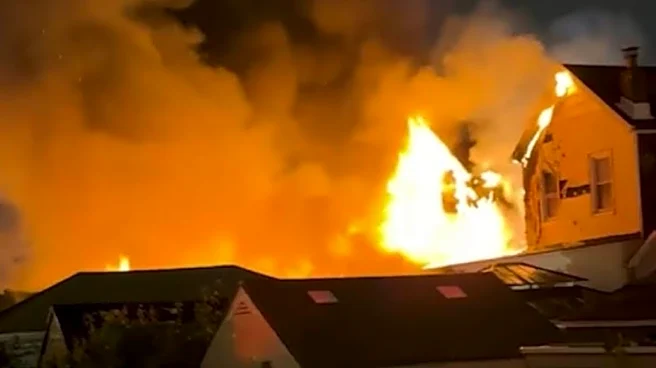Melissa’s top winds are holding at 175 miles (282 kilometres) per hour, the US National Hurricane Centre said in an advisory at 5 p.m. New York time.
The storm’s winds are likely to cause “total structural failure,” the centre said. That’s especially true for higher-elevation areas exposed to the brunt of the storm, where wind speeds could register as much as 30% stronger. The storm, currently about 140 miles southwest of Kingston, is forecast to dump as much as 40 inches (102 centimetres) of rain across parts of Jamaica.
While wind gusts could fluctuate somewhat in the coming hours, Melissa is certain to pack massive storm surge and catastrophic flooding beginning Monday night. If it maintains its strength, Melissa would be the first confirmed Category 5 storm — the highest on the Saffir-Simpson scale — to hit Jamaica.
Jamaican Prime Minister Andrew Holness said in a video statement posted Monday that residents in low-lying and flood-prone areas should be prepared to flee, given the high risk of “complete displacement and loss of life.”
“While we must prepare for the worst, let us also pray for the best,” Holness said, urging residents to check on their neighbours—particularly the elderly and people with disabilities—ahead of the storm’s anticipated arrival Tuesday.
Melissa has already killed at least six people across the Caribbean, including three in Haiti.
The outer bands of Melissa have already knocked out power to about 50,000 people, mostly in western Jamaica, Minister of Local Government and Rural Development Desmond McKenzie said in a televised address late Monday.
Jamaica’s state broadcaster reported that the island’s international airports both halted operations over the weekend. Officials have ordered evacuations in more than a half dozen towns and cities, including Port Royal at the entrance to Kingston Harbour, which dates back to the 17th century.
The town sits on a low-lying spit just west of one of the island’s largest airports — and one of its only international airports. The country’s airport authority has said Norman Manley International is particularly vulnerable to storm surge and coastal erosion from rising seas.
More than 800 shelters have been opened across the island, and local authorities have stepped up drain cleaning and staged heavy equipment to clear debris from roadways.
Though Jamaica is best known for its beaches and resorts, the island is also home to towering mountain ranges with peaks as high as 7,400 feet (2,256 metres). That topography likely will amplify Melissa’s rains, said Andra Garner, a climate scientist at Rowan University.
“It’s also easy to overlook that these winds are likely to be more powerful the farther up you go from sea level,” Garner said.
Melissa is packing enough force to flatten homes, snap trees and touch off power outages that can last for weeks or months. Communities are likely to face widespread communications outages and infrastructure damage, the hurricane centre said.
Jamaica’s losses will be between $5 billion and $16 billion, depending on the exact track across the island, said Chuck Watson, a disaster modeller with Enki Research. There will likely be another $5 billion of losses in Cuba.
Cuban President Miguel Diaz-Canel told his cabinet Monday to “spare no expense” when it comes to making preparations ahead of Melissa’s landfall, despite an ongoing economic crisis that has resulted in shortages of food, medicine and basic goods.
Tracking Hurricane Melissa’s Latest Path
“All scenarios except some kind of divine intervention look utterly devastating at this point,” Watson said.
Jamaica’s ports have been closed to shipping, according to the national port authority. Ahead of the storm, Jamaica had been developing plans for an $80 million expansion at its Kingston Freeport Terminal in an effort to support growing business in global transhipment.
While the data is spotty in places, there is no record of a storm this strong ever hitting Jamaica since 1851, said Phil Klotzbach, a hurricane researcher at Colorado State University. Before Melissa, the most powerful storm to hit the island was Gilbert in 1988, as a Category 4 with winds of about 132 mph.
In the Atlantic this year, Hurricanes Erin and Humberto also reached Category 5, though neither threatened land. Gabrielle hit Category 4, which means four storms have become major hurricanes across the Atlantic in 2025, compared with an average of three by the end of October.
Klotzbach said in an X post that the only other year more than two Category 5 hurricanes formed in the Atlantic was 2005, which produced four — including Katrina, which devastated New Orleans.
A hurricane warning has been issued for the southeastern and central Bahamas and four provinces in Cuba, where Melissa is forecast to hit after devastating Jamaica. Companies there have evacuated workers and the US Navy pulled non-essential personnel out of its base on Guantanamo Bay, Cuba.
Melissa’s slow crawl across the region makes flooding worse because its heaviest rains will linger for days. In a warmer world due to climate change, the atmosphere holds more water, worsening heavy rains from tropical systems.
Melissa can also push a wall of water up to 13 feet into the coastline where it comes ashore. About half of all hurricane deaths come from drowning.
A hurricane watch is in effect for the Turks and Caicos Islands. Flooding rains are also forecast across Haiti and the Dominican Republic, with impacts possible in Bermuda late in the week.
Read Also: Gold spot and futures prices fall below $4,000 for the first time after October 9 as profit booking continues
/images/ppid_59c68470-image-176161509921935026.webp)

/images/ppid_59c68470-image-176146003066388068.webp)
/images/ppid_59c68470-image-17615600265009725.webp)






/images/ppid_59c68470-image-176141503594186851.webp)


